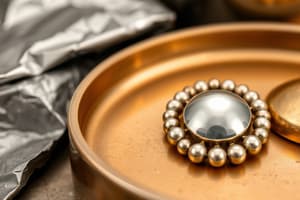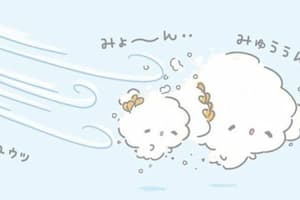Podcast
Questions and Answers
What happens to the color of iron sulphate solution when zinc is added?
What happens to the color of iron sulphate solution when zinc is added?
- It remains light green.
- It turns blue.
- It becomes darker green.
- It becomes colorless. (correct)
Which statement accurately describes the chemical reactivity of zinc compared to iron and copper?
Which statement accurately describes the chemical reactivity of zinc compared to iron and copper?
- Zinc cannot participate in any displacement reactions.
- Zinc is less reactive than both iron and copper.
- Zinc can displace both iron and copper from their salt solutions. (correct)
- Zinc is the least reactive metal in the reaction series.
What type of chemical reaction is demonstrated when iron sulphate reacts with zinc?
What type of chemical reaction is demonstrated when iron sulphate reacts with zinc?
- Double displacement reaction.
- Chemical displacement reaction. (correct)
- Neutralization reaction.
- Oxidation-reduction reaction.
Why does no reaction occur when zinc sulphate is mixed with iron?
Why does no reaction occur when zinc sulphate is mixed with iron?
Which of the following uses of metals is correctly matched?
Which of the following uses of metals is correctly matched?
Which metal is primarily used in the construction of machines?
Which metal is primarily used in the construction of machines?
What is the primary use of zinc in industry?
What is the primary use of zinc in industry?
Which of the following non-metals is used in the production of fertilizers?
Which of the following non-metals is used in the production of fertilizers?
Which metal is specifically noted for its role in biological systems?
Which metal is specifically noted for its role in biological systems?
What is the significance of chlorine in water treatment processes?
What is the significance of chlorine in water treatment processes?
Which of the following metals is used for electroplating?
Which of the following metals is used for electroplating?
What is the role of graphite in machinery?
What is the role of graphite in machinery?
Which metal is known for its strategic importance in defense and space projects?
Which metal is known for its strategic importance in defense and space projects?
What is a chemical displacement reaction?
What is a chemical displacement reaction?
In the reactivity series, where does aluminum rank in comparison to iron?
In the reactivity series, where does aluminum rank in comparison to iron?
What happens to the color of copper sulfate solution when zinc is added?
What happens to the color of copper sulfate solution when zinc is added?
Which of the following metals is the least reactive according to the metals reactivity series?
Which of the following metals is the least reactive according to the metals reactivity series?
Which statement correctly describes a reaction involving copper and iron?
Which statement correctly describes a reaction involving copper and iron?
What type of products are typically formed when a more reactive metal displaces a less reactive one from a solution?
What type of products are typically formed when a more reactive metal displaces a less reactive one from a solution?
What is the significance of the reactivity series in industrial applications?
What is the significance of the reactivity series in industrial applications?
Which non-metal is commonly recognized for its reactivity and usage in fertilizers?
Which non-metal is commonly recognized for its reactivity and usage in fertilizers?
Flashcards
Jewelry Metals
Jewelry Metals
Gold, silver, and platinum are commonly used in making jewelry due to their aesthetic appeal and durability.
Galvanizing
Galvanizing
Zinc is used to coat iron, creating a protective layer against rusting.
Iron's Uses
Iron's Uses
Iron is used in manufacturing machines, tools, and steel for utensils.
Copper's Application
Copper's Application
Signup and view all the flashcards
Aluminum and Titanium: Diverse Uses
Aluminum and Titanium: Diverse Uses
Signup and view all the flashcards
Strategic Metals
Strategic Metals
Signup and view all the flashcards
Tin's Uses
Tin's Uses
Signup and view all the flashcards
Lead's Applications
Lead's Applications
Signup and view all the flashcards
Mercury's Use
Mercury's Use
Signup and view all the flashcards
Electroplating Metals
Electroplating Metals
Signup and view all the flashcards
Oxygen's Role
Oxygen's Role
Signup and view all the flashcards
Sulphur's Uses
Sulphur's Uses
Signup and view all the flashcards
Graphite's Lubricating Property
Graphite's Lubricating Property
Signup and view all the flashcards
Phosphorus's Uses
Phosphorus's Uses
Signup and view all the flashcards
Chlorine's Disinfectant Property
Chlorine's Disinfectant Property
Signup and view all the flashcards
Oxy-hydrogen Flame
Oxy-hydrogen Flame
Signup and view all the flashcards
Iodine's Uses
Iodine's Uses
Signup and view all the flashcards
Reactivity Series of Metals
Reactivity Series of Metals
Signup and view all the flashcards
Metals More Reactive Than Hydrogen
Metals More Reactive Than Hydrogen
Signup and view all the flashcards
Metals Less Reactive Than Hydrogen
Metals Less Reactive Than Hydrogen
Signup and view all the flashcards
Displacement Reaction
Displacement Reaction
Signup and view all the flashcards
Study Notes
Common Metals and Their Uses
- Gold, silver, and platinum are used in making jewelry.
- Zinc is used for galvanizing iron to protect it from rusting.
- Iron is used in making machines and steel for utensils.
- Copper is used in making electrical wires.
- Aluminum and titanium are used in the International Space Station, cooking utensils, aircraft, ships, cars, overhead cables, welding railroad tracks, and other various applications.
- Strategic metals like titanium, chromium, manganese, and zirconium are important for their use in atomic energy, space science projects, jet engines, high-grade steels, and defense equipment.
- Tin is used for soldering, foils, prevents chemical action and corrosion, and panel lighting.
- Lead is used in making water pipes, pigments, batteries, and alloys.
- Mercury is used in thermometers.
- Nickel and chromium are used for electroplating.
Non-metals and Their Uses
- Oxygen plays a crucial role in daily life.
- Sulphur is used in manufacturing sulfuric acid, matchboxes, gunpowder, antiseptic ointments, and in the rubber industry for vulcanization.
- Graphite is used as a dry lubricant in machine parts.
- Phosphorus is used in fertilizers to enhance plant growth and in crackers.
- Chlorine tablets and bleaching powder are used in water purification.
- Hydrogen and oxygen are used in cutting and welding with an oxy-hydrogen flame.
- Iodine is used to prevent thyroid problems, applied as a wound antiseptic, and in medical research to keep tissue samples frozen.
Reactivity Series of Metals
- The reactivity series of metals is a vertical arrangement of metals arranged in a decreasing order of reactivity.
- Metals more reactive than hydrogen include potassium, sodium, calcium, magnesium, aluminum, zinc, iron, nickel, tin, and lead.
- Metals less reactive than hydrogen include copper, mercury, silver, platinum, and gold.
Displacement Reaction
- A displacement reaction occurs when a more reactive element displaces a less reactive element from its aqueous salt solution.
- The metal more reactive in the metal activity series can displace another metal from its salt solution.
- The chemical reaction that takes place in this scenario is called displacement reaction.
Displacement Reaction Examples
- Iron + Copper Sulphate → Iron Sulphate + Copper
- This experiment demonstrates that iron is more reactive than copper, and therefore displaces copper from its salt solution.
- Zinc + Copper Sulphate → Zinc Sulphate + Copper
- Similar to the previous example, zinc is more reactive than copper, and therefore displaces copper from its salt solution.
- Zinc + Iron Sulphate → Zinc Sulphate + Iron
- Zinc is more reactive than iron, and therefore displaces iron from its salt solution.
- Copper + Iron Sulphate → No reaction
- Copper is less reactive than iron and cannot displace iron from its salt solution.
- Iron + Zinc Sulphate → No reaction
- Iron is less reactive than zinc and cannot displace zinc from its salt solution.
- From these observations, it can be concluded that zinc is the most reactive metal, followed by iron, and then copper.
Key Insights on Metal Reactivity
- The metal activity series is a valuable tool to predict the outcome of chemical reactions between metals and their salt solutions.
- The relative reactivity of metals plays an important role in how they interact with each other and with other substances.
- Understanding the concept of displacement reactions provides insight into the fundamental principles of chemical reactivity.
Studying That Suits You
Use AI to generate personalized quizzes and flashcards to suit your learning preferences.





